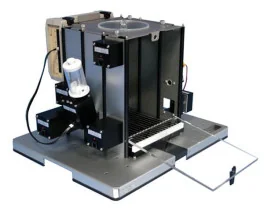Authors
C. Auge, G. Chene, M. Dubourdeau, D. Desoubzdanne, B. Corman et al
Lab
INSERM U1043, Université de Toulouse, Toulouse, France
Journal
European Journal of Pharmacology
Abstract
This work aimed at establishing the relevance of using the in vivo model of cyclophosphamide (CYP)-induced bladder inflammation in rats for in vivo pharmacological studies. Specifically, we measured visceral nociception, identified key inflammatory mediators and evaluated the effects of relevant pharmacological treatments. Cystitis was induced in female rats by a single CYP injection. Sensitivity of the lower abdomen to von Frey mechanical stimulation was determined as a nociceptive parameter. Bladders were assessed for weight, wall thickness and macroscopic damage. Inflammatory mediators were quantified in bladders and urines. The effects of aspirin, ibuprofen and morphine were investigated on all these parameters. A single CYP injection increased nociceptive scores and decreased nociceptive threshold in response to mechanical stimuli between 1 and 4 h post-administration. Increased bladder weight and wall thickness were associated with edema and hemorrhage. Bladder levels of IL-1β, IL-6, MCP-1 and VCAM, and urinary levels of PGE2 were increased. In contrast, a decrease in the urinary metabolites, indoxyl sulfate and pantothenic acid, was observed. Aspirin, ibuprofen and morphine decreased CYP-induced referred visceral pain. Aspirin and ibuprofen also reversed the increased wall thickness, macroscopic damage and levels of IL-1β, IL-6 and PGE2, and the decreased panthotenic acid levels. In contrast, morphine increased wall thickness, edema, hemorrhage, and bladder IL-6 and MCP-1 levels. This work presents a new and reliable method to evaluate visceral sensitivity in rats, and new relevant biomarkers identified in the bladder and urine to measure inflammation and pain parameters for in vivo pharmacological studies.
BIOSEB Instruments Used:
Von Frey Filaments (Bio-VF-M)

 Douleur - Allodynie/Hyperalgésie Thermique
Douleur - Allodynie/Hyperalgésie Thermique Douleur - Spontanée - Déficit de Posture
Douleur - Spontanée - Déficit de Posture Douleur - Allodynie/Hyperalgésie Mécanique
Douleur - Allodynie/Hyperalgésie Mécanique Apprentissage/Mémoire - Attention - Addiction
Apprentissage/Mémoire - Attention - Addiction Physiologie & Recherche Respiratoire
Physiologie & Recherche Respiratoire
 Douleur
Douleur Métabolisme
Métabolisme Système moteur
Système moteur Neurodégénérescence
Neurodégénérescence Thématiques transversales
Thématiques transversales Système musculaire
Système musculaire Functions de motricité générale
Functions de motricité générale Troubles de l'humeur
Troubles de l'humeur Autres pathologies
Autres pathologies Articulations
Articulations Système Nerveux Central (SNC)
Système Nerveux Central (SNC)  Système sensoriel
Système sensoriel Bioseb on booth #14 at OARSI 2024 in Vienna
Bioseb on booth #14 at OARSI 2024 in Vienna 